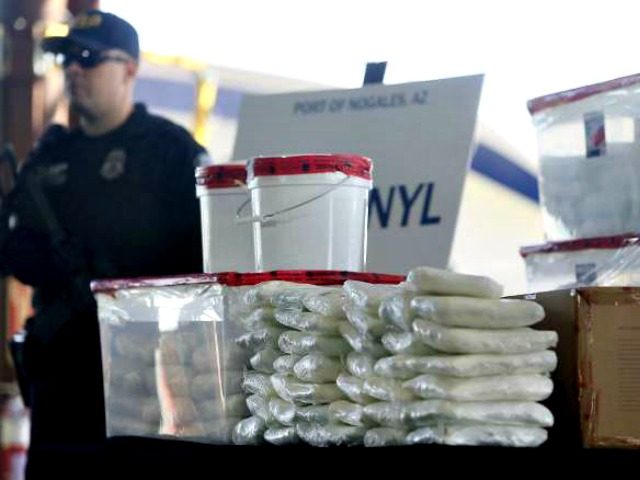U.S. Customs and Border Protection (CBP) data provide insight into cartels’ most recent shift in narcotics smuggling and their impacts on American citizens in 2020. The data show an increase in seizures of methamphetamine and fentanyl along the U.S.-Mexico Border.
Data provided from the CBP Office of Field Operations (OFO) clearly shows a dramatic surge in methamphetamine seizures at the nation’s ports of entry during the first three months of Fiscal Year 2020. Officers seized 40,882 pounds in total. This is significant, considering in all of FY 2019, the agency seized 68,858 pounds — the most ever recorded in a single year. Fentanyl seizures in all Fiscal Year 2019 were the highest-ever recorded as well at 2,545 pounds. During the first three months of FY 2020, officers seized 530 pounds.
Office of Field Operations Nationwide Drug Seizures
The figures reflect FY 2014 – FY 2019 and FY20-to-Date (TD). Fiscal Year 2020 runs October 01, 2019 – September 30, 2020.
| FY 14 | FY 15 | FY 16 | FY 17 | FY 18 | FY 19 | FY20 TD DEC | |
| Cocaine | 45,323 | 38,346 | 52,838 | 62,415 | 51,592 | 89,207 | 12,532 |
| Heroin | 4,356 | 6,023 | 4,224 | 3,398 | 5,205 | 5,427 | 1,331 |
| Marijuana | 438,146 | 602,821 | 516,122 | 366,627 | 299.419 | 289,529 | 86,179 |
| Methamphetamine5 | 19,613 | 25,495 | 33,086 | 46,247 | 57,440 | 68,585 | 40,882 |
| Fentanyl | n/a | 70 | 596 | 1,875 | 1,895 | 2,545 | 530 |
Table, U.S. Customs and Border Protection
U.S. Border Patrol, which operates between ports of entry in an uncontrolled environment, also observed a record surge in meth and fentanyl. During the first three months of FY 2020, agents seized 4,158 pounds of meth. This is also significant considering that in all of FY 2019, the agency seized an annual record — 14,434 pounds. Additionally, fentanyl seizures in all of Fiscal Year 2018 were the highest-ever at 388 pounds. In the first three months of FY 2020, Border Patrol agents seized 139 pounds. This year, Border Patrol is on the path to more hard drugs than ever before in the agency’s history.
U.S. Border Patrol Nationwide Drug Seizures
Numbers below reflect FY 2014 – FY 2019 and FY20 To Date (TD). Fiscal Year 2020 runs October 01, 2019 – September 30, 2020.
| FY 14 | FY 15 | FY 16 | FY 17 | FY 18 | FY 19 | FY20 TD DEC | |
| Cocaine | 4,554 | 11,220 | 5,473 | 9,346 | 6,550 | 11,682 | 5,819 |
| Heroin | 606 | 518 | 566 | 953 | 568 | 808 | 190 |
| Marijuana | 1,922,545 | 1,538,307 | 1,294,052 | 861,231 | 461,030 | 266,882 | 74,351 |
| Methamphetamine | 3,930 | 6,443 | 8,224 | 10,328 | 11,314 | 14,434 | 4,158 |
| Fentanyl | n/a | n/a | 105 | 181 | 388 | 226 | 139 |
Table, U.S. Customs and Border Protection
These data may serve as a significant tripwire for the White House, executive leadership of the DEA, and the Office of National Drug Control Policy by marking another flashpoint between the U.S. and Mexican cartels.
On January 30, 2020, DEA released its annual 2019 Drug Threat Assessment Report. The data, however, largely reflect actions in 2017. However, the report notes that roughly 192 people died every day from drug poisoning in the U.S. during President Donald Trump’s first year in office. Since that time, seizure data from elsewhere regarding methamphetamine and fentanyl have exhibited dramatic increases year over year.
Why is this occurring?
The answer is two-fold. First, Mexican cartels are seeing ratcheting demand for narcotics like methamphetamine, fentanyl, or the combination of both known as “super meth.” Cartels are wasting no time in adjusting to the market as marijuana access laws loosen among U.S. states.
The second reason is due to the cost of a cartel war. Historically, one or two major regional conflicts could occur between factions. Today, we are witnessing something comparable to a world war. Virtually all territories, routes, and products are currently being contested. At the same time, Mexico City has undergone its traditional reshuffling of the security apparatus while recently adopting a policy of de-militarization. Related casualties are worse now than ever since record-keeping began.
The cost overhead of a cartel war pushes them to move more product, be it drugs, people, or fuel. Naturally, the spike in volume through contested areas can only engender more bloodshed. This vicious cycle reached the point in December 2019–shortly before the Christmas travel season–for the U.S. State Department to renew its travel warning for 16 of the 32 states in Mexico.
Jaeson Jones is a retired Captain from the Texas Department of Public Safety’s Intelligence and Counterterrorism Division and a Breitbart Texas contributor. While on duty, he managed daily operations for the Texas Rangers Border Security Operations Center.

COMMENTS
Please let us know if you're having issues with commenting.